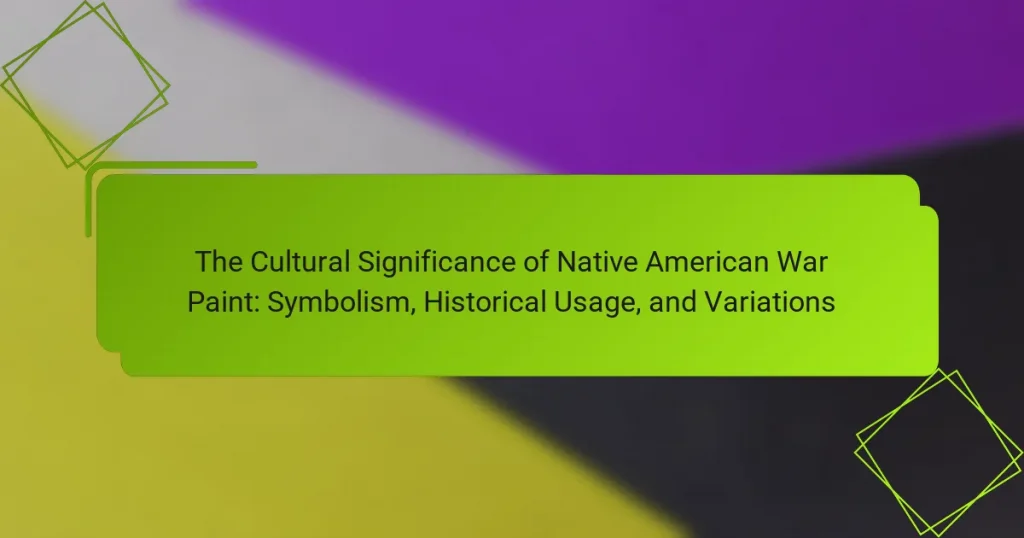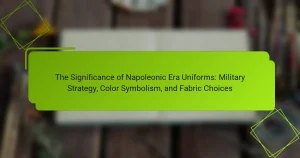Native American war paint is a culturally significant practice that served as a form of identity and expression for various tribes. Each tribe employed distinct colors and patterns, each carrying specific symbolic meanings related to bravery, protection, and spirituality. The application of war paint was often a communal ritual performed before battles or significant events, reinforcing social bonds and invoking strength. Historical accounts reveal that the Lakota, Navajo, Apache, and Iroquois, among others, had unique styles and meanings associated with their war paint, reflecting their diverse cultural beliefs and practices. This article explores the symbolism, historical usage, and variations of Native American war paint, highlighting its importance in the cultural and spiritual practices of these communities.
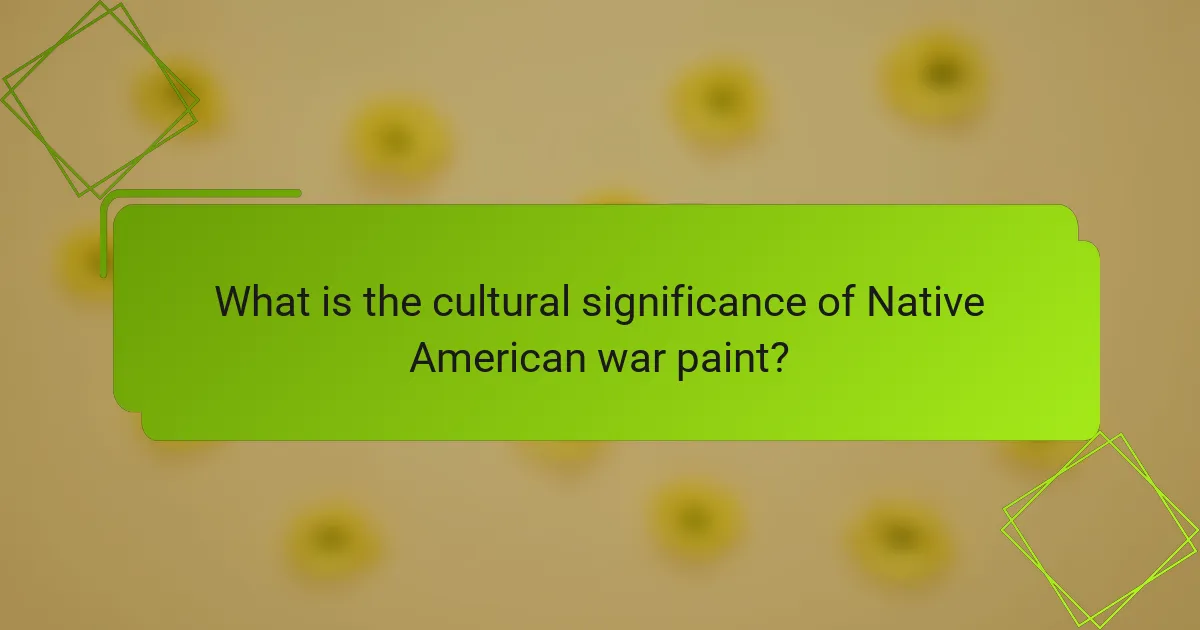
What is the cultural significance of Native American war paint?
Native American war paint holds significant cultural meaning. It served as a form of identity and expression for various tribes. Each design and color had specific symbolism, representing bravery, protection, and spiritual beliefs. War paint was often applied before battles or important events. It was believed to invoke strength and courage. Historical accounts indicate that different tribes had unique styles and meanings associated with their war paint. For example, the Lakota used red for courage and black for strength. The application of war paint was also a communal activity, strengthening social bonds within tribes. Overall, war paint played a crucial role in the cultural and spiritual practices of Native American communities.
How did Native American war paint originate?
Native American war paint originated as a means of identification and expression during conflicts. Tribes used natural pigments from minerals, plants, and animal sources to create vibrant colors. Each color and pattern had specific meanings, often representing bravery, strength, or affiliation with a particular group. Historical records indicate that war paint was applied before battles to invoke spiritual protection and intimidate enemies. The practice varied significantly among tribes, showcasing unique cultural identities. Evidence from archaeological findings shows that the use of war paint dates back thousands of years, indicating its deep-rooted significance in Native American culture.
What materials were traditionally used in the creation of war paint?
Traditional war paint was created using natural materials. Commonly used substances included ochre, charcoal, and clay. Ochre provided red and yellow pigments. Charcoal offered black hues, while clay contributed white shades. These materials were often mixed with animal fat or water for application. Native American tribes utilized local resources, reflecting their environment. The choice of colors and materials often held cultural significance. Each tribe had unique formulas and techniques for creating war paint.
How did the techniques for applying war paint evolve over time?
The techniques for applying war paint evolved significantly over time. Initially, Native Americans used natural pigments from minerals, plants, and animal sources. They applied these pigments using fingers, brushes made from animal hair, or sticks. Over time, the methods became more sophisticated. Tribes began to develop distinct styles and patterns that represented individual identities and tribal affiliations.
As contact with European settlers increased, new materials and tools became available. This included commercial paints and brushes, which altered traditional practices. Some tribes incorporated these innovations while maintaining their cultural significance.
The evolution of techniques also reflected changes in warfare and cultural practices. As the purpose of war paint expanded beyond battle to include rituals and ceremonies, the application techniques adapted accordingly. This evolution highlights the dynamic nature of cultural expressions among Native American tribes.
Why is symbolism important in Native American war paint?
Symbolism is important in Native American war paint because it conveys identity, status, and spiritual beliefs. Each color and design has specific meanings tied to tribal traditions. For example, red may symbolize bravery, while black can represent strength. War paint serves not only as a form of decoration but also as a communication tool. It signifies preparation for battle and invokes protection from spirits. Historical accounts show that warriors adorned themselves with paint to intimidate enemies. The symbolism in war paint is deeply rooted in cultural heritage and collective memory. This practice fosters unity and reinforces community values among tribes.
What do different colors and patterns represent in war paint?
Different colors and patterns in war paint represent various cultural meanings and individual identities. For example, red often symbolizes bravery or bloodshed, while black can signify strength or mourning. Blue may represent peace or protection, and white is often associated with purity or spiritual connection. Patterns can indicate tribal affiliation or personal achievements in battle. Historical records show that these colors and patterns were not random; they were deeply rooted in the beliefs and traditions of Native American cultures. Each warrior’s choice of color and design conveyed specific messages to allies and enemies alike.
How does war paint reflect individual tribal identities?
War paint reflects individual tribal identities through unique designs and colors. Each tribe has distinct patterns that symbolize their cultural heritage. Specific colors often represent different meanings, such as bravery or protection. The application of war paint varies among tribes, showcasing individual customs and beliefs. Historical records indicate that tribal members used war paint to signify their status in battle. For example, the Lakota Sioux used red to symbolize strength and courage. Additionally, the designs can include symbols of animals or natural elements important to a tribe’s identity. Overall, war paint serves as a visual representation of a tribe’s values and history.
What role did war paint play in Native American warfare?
War paint served as a crucial element in Native American warfare. It was used to intimidate opponents and enhance the warrior’s appearance. Different colors and patterns held specific meanings, symbolizing bravery, strength, or spiritual protection. Warriors often applied war paint before battles to prepare mentally and spiritually. The application of paint was also a communal activity, fostering unity among warriors. Historical accounts indicate that tribes believed war paint could invoke the spirits for guidance and protection. Additionally, the use of war paint varied among tribes, reflecting their unique cultural identities. This practice was deeply embedded in their traditions and rituals surrounding warfare.
How was war paint used before a battle?
War paint was used by Native American warriors before a battle to signify readiness and bravery. The application of war paint often involved intricate designs and colors that represented personal or tribal symbols. Warriors believed that the paint provided protection and invoked the spirits of ancestors. Specific colors were chosen for their meanings; for example, red often symbolized courage, while black could signify strength. The process of painting was a ritualistic act, enhancing the warriors’ mental preparation for combat. Additionally, war paint served as a psychological tool, intimidating enemies and fostering unity among the warriors. Historical records indicate that various tribes had unique styles and meanings associated with their war paint, reflecting their cultural identities.
What were the rituals associated with applying war paint?
Rituals associated with applying war paint included various ceremonial practices. These rituals often involved preparation, such as gathering natural pigments. Participants would typically engage in prayers or chants to invoke protection or strength. The application of paint was often done in a communal setting, emphasizing unity. Specific designs held different meanings, representing personal achievements or tribal identity. Some tribes used the ritual to mark significant events, like preparing for battle. The process was deeply spiritual, connecting individuals to their ancestors. Overall, these rituals reinforced cultural values and community bonds.
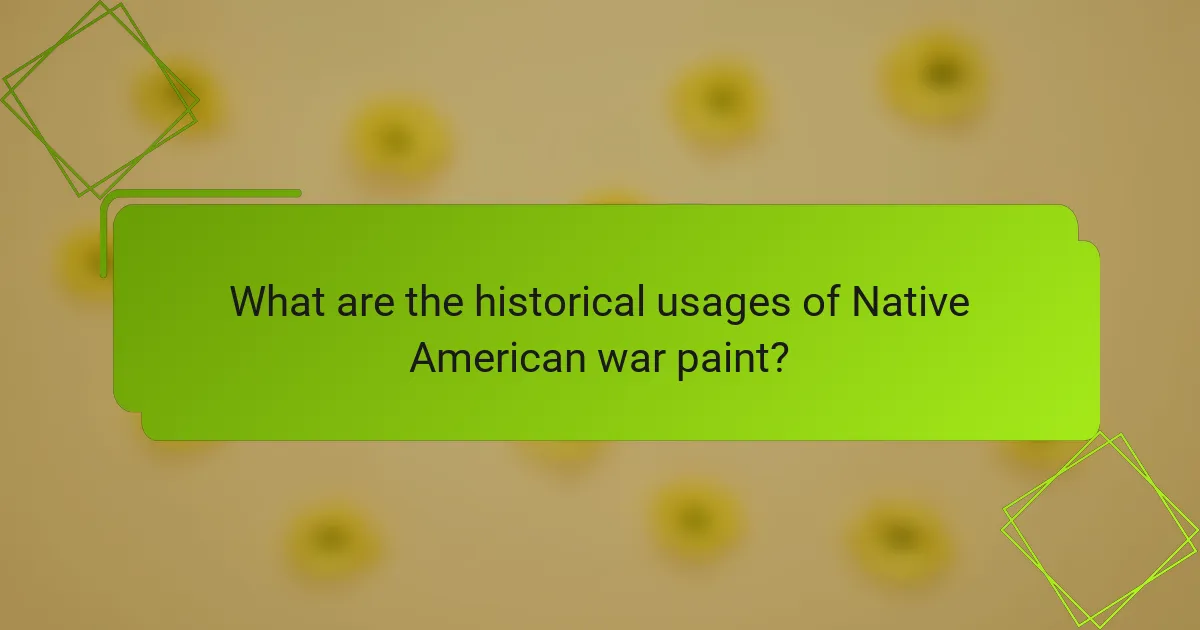
What are the historical usages of Native American war paint?
Native American war paint historically served various purposes, primarily for identification and intimidation in battle. Different tribes used distinct colors and patterns to signify individual warriors, clan affiliation, or tribal identity. War paint was also believed to provide spiritual protection and invoke the power of ancestors. Specific colors held symbolic meanings; for instance, red often represented bravery, while black could signify death or mourning. Additionally, the application of war paint was a ritualistic practice, often accompanied by prayers or songs. The usage of war paint varied significantly between tribes, reflecting their unique cultural beliefs and practices. Historical records indicate that war paint was applied before battles and during other significant events, reinforcing its importance in Native American culture.
How has the usage of war paint changed over different periods?
The usage of war paint has evolved significantly across different historical periods. Initially, Native American tribes used war paint for spiritual and ritualistic purposes. It served as a means of protection and a way to invoke strength before battle. Over time, the application of war paint became more symbolic, representing tribal identity and achievements. In the 19th century, with increased European contact, the use of war paint adapted to include new colors and materials. Today, war paint is often seen as a cultural symbol rather than a practical tool for warfare. Its usage has shifted towards ceremonial and artistic expressions, reflecting a broader cultural heritage.
What historical events influenced the evolution of war paint practices?
The evolution of war paint practices was influenced by various historical events. Notably, the conflicts between Native American tribes and European settlers shaped the use of war paint. The introduction of new materials and colors from European trade altered traditional practices. Additionally, the American Revolutionary War prompted tribes to adopt war paint for identity and resistance. The War of 1812 further solidified the symbolic use of war paint as a means of asserting cultural heritage. Each of these events contributed to the adaptation and significance of war paint in Native American culture.
How do historical accounts document the use of war paint in battles?
Historical accounts document the use of war paint in battles through various cultural narratives and artifacts. Indigenous tribes often described the application of war paint as a means to invoke spiritual protection and enhance bravery. Historical texts, such as the journals of early explorers and military reports, provide detailed observations of war paint’s role in warfare. For example, accounts from the 19th century mention specific colors and patterns used by tribes, indicating their significance in battle preparations. Additionally, archaeological findings, including painted artifacts and clothing, support these historical narratives. These documents collectively illustrate how war paint was integral to the identity and strategy of Native American warriors during conflicts.
Why is it important to preserve the history of Native American war paint?
Preserving the history of Native American war paint is crucial for cultural heritage. War paint served as a means of identity and expression among tribes. It reflected individual and communal values, beliefs, and social status. Historical documentation of these practices helps maintain cultural continuity. The techniques and meanings associated with war paint are often passed down through generations. Loss of this knowledge could result in diminished cultural identity. Additionally, understanding war paint contributes to the broader narrative of Native American history. This preservation fosters respect and recognition of Indigenous cultures.
What challenges do historians face in documenting the history of war paint?
Historians face several challenges in documenting the history of war paint. One major challenge is the lack of written records from Native American cultures. Many tribes relied on oral traditions, which can lead to variations in stories and meanings. Additionally, war paint practices varied significantly across different tribes, complicating the establishment of a unified historical narrative.
Another issue is the potential for cultural appropriation and misinterpretation by outsiders. This can distort the original meanings and purposes of war paint. Furthermore, the materials used for war paint were often organic and ephemeral, making physical evidence rare. This scarcity limits the ability to analyze and understand historical uses fully.
Finally, modern perceptions and commercialization of Native American culture can influence historical interpretations. This creates a challenge for historians seeking to present an accurate account of war paint’s significance and usage.
How can modern interpretations affect the understanding of historical practices?
Modern interpretations can significantly reshape the understanding of historical practices. They provide contemporary perspectives that may alter the perceived meanings of traditional activities. For instance, modern views on Native American war paint may emphasize its spiritual significance rather than solely its martial purpose. This shift can lead to a deeper appreciation of the cultural context behind the practices. Scholars often analyze historical documents and artifacts to draw connections between past and present interpretations. Such analyses can reveal how societal values influence the understanding of these practices over time. Additionally, modern interpretations can challenge stereotypes and misconceptions surrounding historical practices. They often encourage a more nuanced view that acknowledges the complexity of cultural traditions.
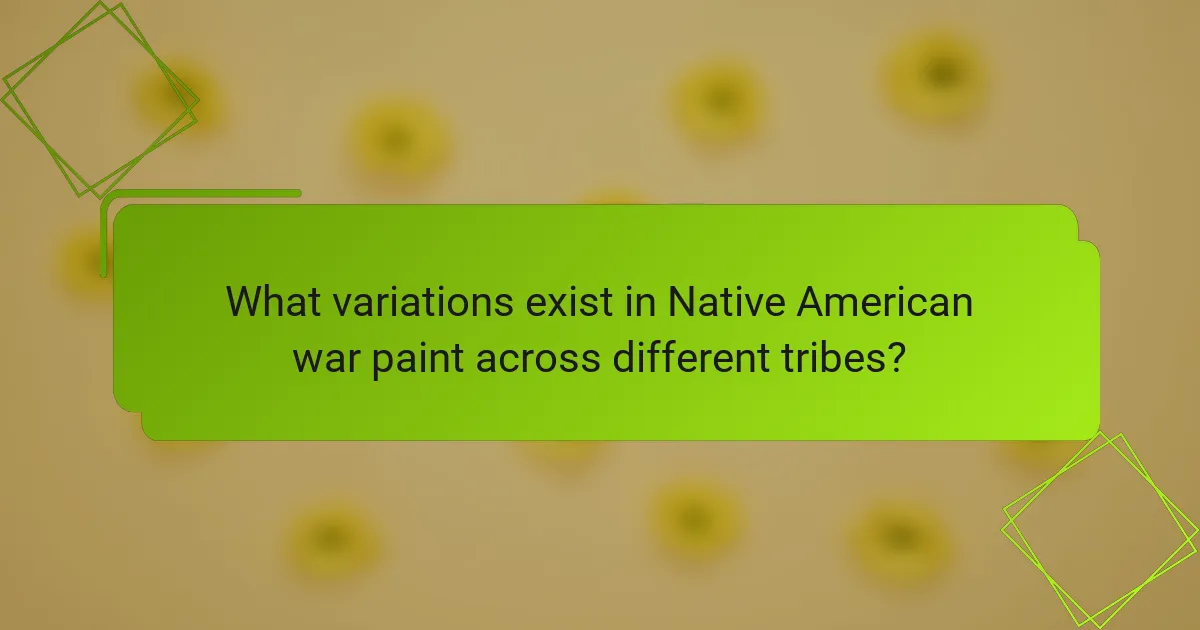
What variations exist in Native American war paint across different tribes?
Native American war paint varies significantly across different tribes. Each tribe has its unique colors, patterns, and meanings associated with war paint. For example, the Lakota Sioux often used red and black to symbolize bravery and strength. The Navajo utilized a variety of colors, like white for purity and yellow for happiness.
In contrast, the Apache favored dark colors to signify stealth and surprise. The Iroquois used intricate designs that represented personal accomplishments in battle. These variations reflect each tribe’s cultural beliefs and values. Historical records indicate that war paint was not merely decorative but held deep spiritual significance.
Furthermore, the application techniques varied, with some tribes using brushes made from animal hair, while others applied paint with their fingers. This diversity in war paint illustrates the rich tapestry of Native American cultures and their unique expressions of identity.
What are the distinct styles of war paint among various tribes?
Distinct styles of war paint among various tribes include unique patterns and colors that reflect cultural significance. For example, the Lakota tribe often used red and black colors to symbolize strength and power. The Cherokee tribe utilized intricate designs that represented their clan identity. The Apache commonly employed stripes and dots, which conveyed personal and spiritual meanings. The Ojibwe tribe favored earth tones and natural pigments, highlighting their connection to nature. Each tribe’s war paint style served as a visual language, communicating individual and collective identities. Historical records confirm these practices, emphasizing their role in tribal warfare and ceremonies.
How do cultural differences influence war paint designs?
Cultural differences significantly influence war paint designs by dictating the colors, patterns, and meanings associated with the paint. Various Native American tribes utilize distinct colors based on their cultural beliefs and environmental surroundings. For example, red often symbolizes bravery, while black may represent mourning. Patterns can also vary; some tribes may use stripes or dots to convey specific messages or tribal affiliations. Historical contexts play a role as well, with certain designs evolving from traditional practices or influenced by interactions with other tribes. The significance of these variations highlights the rich tapestry of cultural identity and values in warfare practices among different groups.
What are some unique practices related to war paint in specific tribes?
The unique practices related to war paint in specific tribes include various symbolic applications and rituals. For instance, the Lakota Sioux tribe uses war paint to signify bravery and readiness for battle. They apply specific colors and patterns to represent different spiritual meanings. The Navajo tribe incorporates natural pigments and often uses paint to invoke protection and strength. Their designs are deeply rooted in their cultural beliefs. The Apache tribe emphasizes the use of war paint as a form of personal expression during warfare. Each warrior’s design is unique to their personal experiences and achievements. The Ojibwe tribe utilizes war paint in ceremonial contexts, often linked to their connection to nature and [censured]. These practices highlight the diverse significance of war paint across different tribes in North America.
How do contemporary artists interpret traditional war paint?
Contemporary artists interpret traditional war paint by blending historical significance with modern artistic expression. They often use traditional motifs and colors to convey cultural heritage. Artists may incorporate war paint into contemporary art forms, such as installations or mixed media. This approach highlights the ongoing relevance of Indigenous identity. Some artists also critique historical narratives surrounding war paint. They challenge stereotypes and promote a deeper understanding of Native American cultures. By doing so, they foster dialogue about cultural appropriation and representation. This interpretation serves to preserve traditions while engaging with contemporary issues. Overall, this fusion creates a dynamic conversation between past and present.
What modern materials and techniques are used in contemporary war paint?
Contemporary war paint utilizes synthetic pigments, natural dyes, and biocompatible materials. Synthetic pigments provide vibrant colors and durability. Natural dyes, derived from plants and minerals, offer traditional aesthetics. Biocompatible materials ensure skin safety during application. Techniques include airbrushing for smooth application and layering for depth. Additionally, some artists incorporate digital design before physical application. These modern methods enhance both visual impact and cultural expression.
How do contemporary interpretations honor or alter traditional meanings?
Contemporary interpretations of Native American war paint often honor traditional meanings while also altering them. Modern artists and cultural practitioners frequently respect the historical significance of colors and patterns. They may incorporate traditional designs into contemporary art forms, thus preserving cultural heritage. However, some interpretations adapt these symbols to reflect current social issues. This can lead to a reinterpretation of meanings that resonates with contemporary audiences. For instance, war paint may now symbolize resilience in the face of modern challenges. These adaptations can foster a dialogue between past and present, allowing for cultural evolution. Overall, contemporary interpretations serve to both honor and transform the significance of traditional war paint.
What are practical tips for understanding and appreciating Native American war paint?
To understand and appreciate Native American war paint, study its historical context and significance. Each design often reflects cultural beliefs and tribal identity. Research the specific tribes and their unique styles of war paint. Explore the meanings behind colors and symbols used in the paint. Attend cultural events or exhibitions to see war paint in practice. Engage with Native American artists and historians for firsthand insights. Read literature or watch documentaries that focus on Native American traditions. Understanding the stories and purposes behind the war paint enhances appreciation. Recognizing its role in ceremonies and battles provides deeper cultural context.
The main entity of this article is Native American war paint, which holds significant cultural meaning across various tribes. The article explores its symbolism, including colors and patterns that convey identity, bravery, and spiritual beliefs. It examines the historical origins and materials used in creating war paint, as well as the evolution of application techniques over time. Furthermore, the article discusses the communal rituals associated with war paint, its role in warfare, and the variations in practices among different tribes. Lastly, it highlights contemporary interpretations and the importance of preserving the history of war paint within Native American culture.
